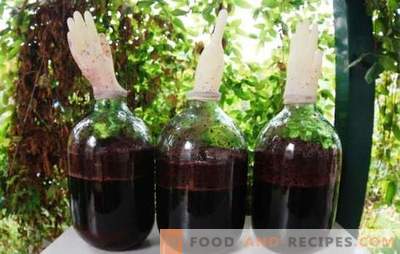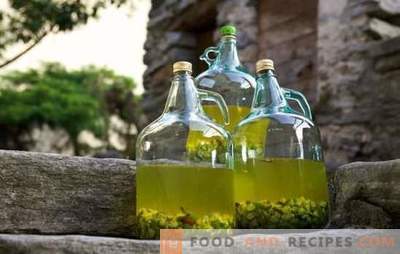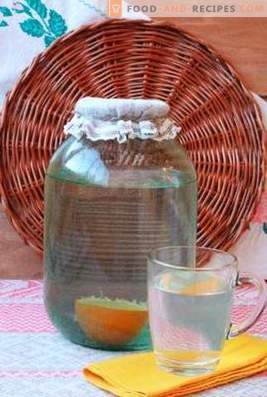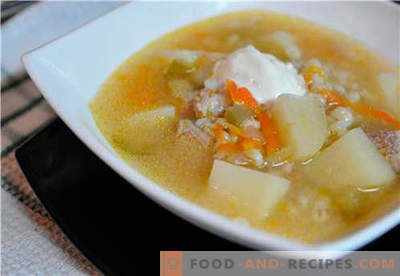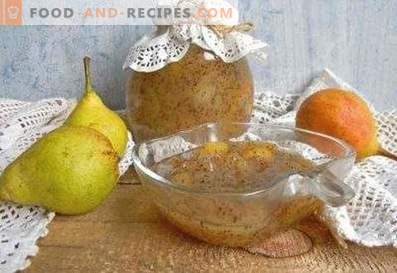
Chacha, also known as wine, is brandy alcohol, a product that can be cooked at home.
Ideally, of course, use your own harvest. In the absence of this, purchased berries will also be used.
With a balanced approach and proper recipe, you get a great drink, high strength and excellent taste.
And how much pride the owners can add to the fact that crystal clear alcohol is homemade chacha from grapes at home!
Chacha from grapes at home - the necessary equipment
To make chacha, you will need a large pot, a basin or a pan for cooking oilcake, one or several containers for fermenting the wort, on the neck of which a hydraulic lock is installed, and a distillation apparatus.
Additionally, you must have a gauze or sieve for filtering the finished wort, an alcohol meter and an instrument for measuring acidity.
To purify the distillate, manganese, wood or activated carbon, funnel and cotton wool may be required. Stock up with special filter paper.
Chacha from grapes at home - picking grapes
When choosing grapes is to stay on varieties with high acidity. It is not recommended to use gentle Turkish or Iranian grapes; Crimean, Krasnodar and Caucasian grapes of “wine berry” are best suited.
Which sort is better to take? It is difficult to answer this question, as they say, this is a matter of taste. When using early white grape varieties, you get a light chacha with the most pronounced aroma of freshness and light “sour” in the aftertaste. Dark and late varieties, as well as slightly dried grapes give the drink soft tones with a deep, deep aroma. Chacha turns out to be the most saturated if you mix several varieties of “tartberry”.
The basis of chacha is mash and the quality of the product itself depends on how properly it is delivered. Braga can be made from fresh grapes or remaining after making wine or juice cake. Fresh grapes are not recommended to be washed before use, since on the surface of the grapes there is a white patina containing wild yeast, which ensures rapid natural fermentation. But if there is no certainty that the crop was not treated with chemicals, it is better to wash it. The clusters prepared for making chacha are carefully examined, cutting off all the leaves and rotted berries. After that, the grapes are crushed with their hands, turning into oilcake. You can crush as separated berries, and whole clusters with combs.
When using marc remaining from cooking wine, if they have already participated in fermentation, it should be noted that they need to be taken twice as much. They have already given away some of the wine necessary for making chachi.
Fermentation of grapes
To obtain a high-quality product, the fermentation is recommended without sugar. But in most cases, it is still added, contrary to all the rules, to speed up fermentation or increase the yield of the final product.
Yeast is rarely used; they, like sugar, accelerate the process of active fermentation. As mentioned above, it is better to use wild yeast on the surface of the grapes. If for any reason you still need to add yeast, take only alcohol, in any case, do not put wort on baking yeast!
The quality of water added to the wort plays an important role. It is impossible to introduce distilled, and it is desirable to pass the plumbing through a multistage filter or to allow it to settle. Heavy impurities will settle, and the chlorine used to treat it will evaporate.
The temperature mode of fermentation affects both the taste of chacha and its flavor. It is desirable to conduct the process at a low temperature, from 14 to 20 degrees. It can last for a long time, from one to one and a half months and leads to the formation of esters and aldehydes, which enhance the aroma of the distillate. It is possible to withstand a higher temperature regime, from 20 to 30 degrees, but the quality of the final product will suffer, the precious aroma, which the well-prepared chacha is famous for, will be lost. Properly placed mash, subject to temperature, should be covered with bubbles, gurgle well, and the pulp in it float to the surface. During the whole time of fermentation, the pulp should be given special attention. So that it does not become covered with mold, the wort must be stirred daily, trying to lower the pulp to the bottom.
Braga is considered ready when bubbles cease to appear in it, the mash has settled to the bottom, and the liquid has become much brighter. If you give a lit match to the bottle neck with the fermented braga, it will not go out. Readiness of home brew is also established with the help of an instrument suitable for this purpose - a hydrometer. After lowering in a well-fermented raw material, when the instrument reads less than 1.002, the brago can be safely put on the stage.
Distillation of brew
Overtake the mash for chacha as usual moonshine. For distillation, you can take the fermented wort as it is, with cake and sediment. You can make distillation in two stages - first overtake the expressed wort, and then the cake with precipitation. The acidity of the product to be distilled should not be less than or greater than 3.2-3.0. Check its level can be a special device - PH meter.
The finished wort is poured into the distillation apparatus - a cube, and put on moderate heat. The first 10% of the product must be drained, this is the so-called pervak or “head”. Drain - does not mean throwing away, this practically pure alcohol of high concentration can be used for external use or for technical purposes. Then, the main fraction of the future chacha is selected, while its strength is constantly monitored by an alcohol meter. Collect the distillate is stopped when the degree decreases in forty degrees. In the absence of an alcohol meter, to determine the strength, you can use the old “old-fashioned” method - set fire to the distillate in a spoon. If it burns, then its fortress is still sufficient. The last part, the “tail,” is collected separately.
The primary distillate is necessarily half diluted with pure water and distilled again, also breaking (dividing) into fractions. Already finished chacha is collected after “pervak” before the drink is lowered to forty degrees.
After the primary distillation, homemade tea must be cleaned.
Purification of primary distillate
Purification of the primary distillate can be done using several proven methods: through special paper, activated or charcoal, as well as using potassium permanganate.
When using wood or activated carbon, it is placed in a funnel on the cotton wool laid in it and a distillate is poured in a thin stream. The slower it flows, the cleaner the chacha will turn out.
Cleansing with potassium permanganate requires not only patience, but also care. For each liter of distilled product you need to take at least 50 ml of hot drinking water and 2 grams. manganic acid potassium. The potassium permanganate dissolved in hot water is poured into the primary distillate and allowed to stand for at least 10 hours, after which it is carefully filtered through the cotton wool laid in the funnel.
Purified chacha is distilled again. Before this, the moonshine still is thoroughly washed, and the distillation is carried out in the same manner as for the first time, with the “head” and “tail” cut off.
The “head” can be used for domestic needs, and the “tail” can be used for re-distillation.
Homemade chacha from grapes: a simple recipe without yeast from juice
Ingredients:
• 15 kg of ripened grapes, preferably Rkatsiteli;
• 5 kg of sugar;
• filtered drinking water - 15 liters.
Cooking Method:
1. Well knead the selected grapes with your hands, trying to crush each grape.
2. Add water to the resulting mass, pour in granulated sugar. Mix well and transfer to a container prepared for fermentation. Be sure to install a water seal on the neck and place it for digestion in a room with a temperature of 14 to 25 degrees.
3. After fermentation, when carbon dioxide stops flowing through the trap, drain the ready wort through a sieve or gauze folded in several layers. Separated wort is poured into a cube, and tie a little well-pressed cake into a fabric bag and hang inside the moonshine. The cake will saturate the distillate with grape aroma.
4. Distill the wort over low heat, cutting off the “head” —that is, draining about 100 ml of distillate, and collect the main fraction in a separate container until the strength is reduced to less than 40 degrees. Collect the remaining “tail” in a separate dish and set aside. 5. Purify the primary distillate using one of the methods described above and put in secondary distillation. In spite of the fact that moonshine was cleared, at repeated distillation, the “head” and “tail” are also cut off.
6. Cool the re-distilled chacha and bring it to the desired strength. To lower the fortress, dilute the chacha with boiled cold water.
7. After that, pour the distillate into the bottles and leave to infuse for 10 days to two weeks, after which it should be drained very carefully, without splitting the residue, approximately the thickness of the little finger, drain from the bottle to the selected “tails”. After that, chacha will be ready finally.
Homemade chacha from grapes: a simple recipe with yeast from the marc
Ingredients:
• 10 liters of non-fermented husks;
• 5 kg of sugar;
• 30 liters of drinking filtered water;
• 10 gr. fresh alcoholic yeast.
Cooking Method:
1. Warm up the water to 30 degrees, dissolve the yeast crumbled in hands, add sugar. Again, mix everything thoroughly to dissolve the sugar crystals and add the mixture to the marc, mix. If you are using previously used raw materials in the fermentation, take it twice as much, at least 20 liters.
2. Pour the prepared mash into the fermentation tank, install the water trap and place it in a room with the desired temperature. Consider that the process proceeded well, the temperature of the air in the room should not fall below 14 degrees and be above 28 degrees. When the mode is chosen incorrectly, the activity of the yeast decreases and the wort does not ferment.
3. Fermented must must be distilled twice on a moonshine with intermediate distillate filtration. During both primary and secondary distillation, cut off the “heads” and “tails”.
4. Leave the prepared chacha for a fortnight to infuse, spilling on a clean container.
Homemade chacha from grapes: a simple recipe from oil cake, without sugar and yeast
Ingredients:
• Grapes of any variety or mix of several varieties.
Cooking method:
1. Bunches of cooked grapes put in a large pot, mash the berries well with your hands. Cover the container with gauze and clean the room with the recommended temperature above. 2. Stir the cake well every day, trying to lower the hat that has risen to the top.
3. About a week later, when all the oilcake rises up, drain off the fermented juice and distille it twice. After the primary distillation, be sure to clean the distillate with manganese or coal.
4. The remaining extracts can be reused or used for flavoring distilled chacha, tied in a gauze bag and hanging inside the moonshine.
5. After the secondary distillation, pack the chacha in clean glass containers and leave to infuse for a couple of weeks.
Making chacha from grapes at home - cooking tricks and useful tips
• If you are harvesting chacha yourself, do not do it right after the rain. Wait a few days for the berries to become covered in wild yeast.
• Frozen grapes roam faster. Place the selected bunches for several hours in the freezer. Thaw the berries in a container in which you will crush the grapes.
• Crush a “wine berry” preferably with gloves to protect your hands from the effects of fruit acid.
• Do not clean distilled distilled milk, it may affect the taste of the product. This method is good when working with less high-quality raw materials made from beets, a mixture of berries or sugar-candy types of mash.
• If you want to give the drink a light cognac hue, infuse distilled chacha in oak barrels or add a few oak chips to the glass container.
• Simple recipes and the necessary equipment suitable for making homemade chacha from grapes are not at all so inaccessible, there are many specialized forums in which you will be told what to buy and where.



